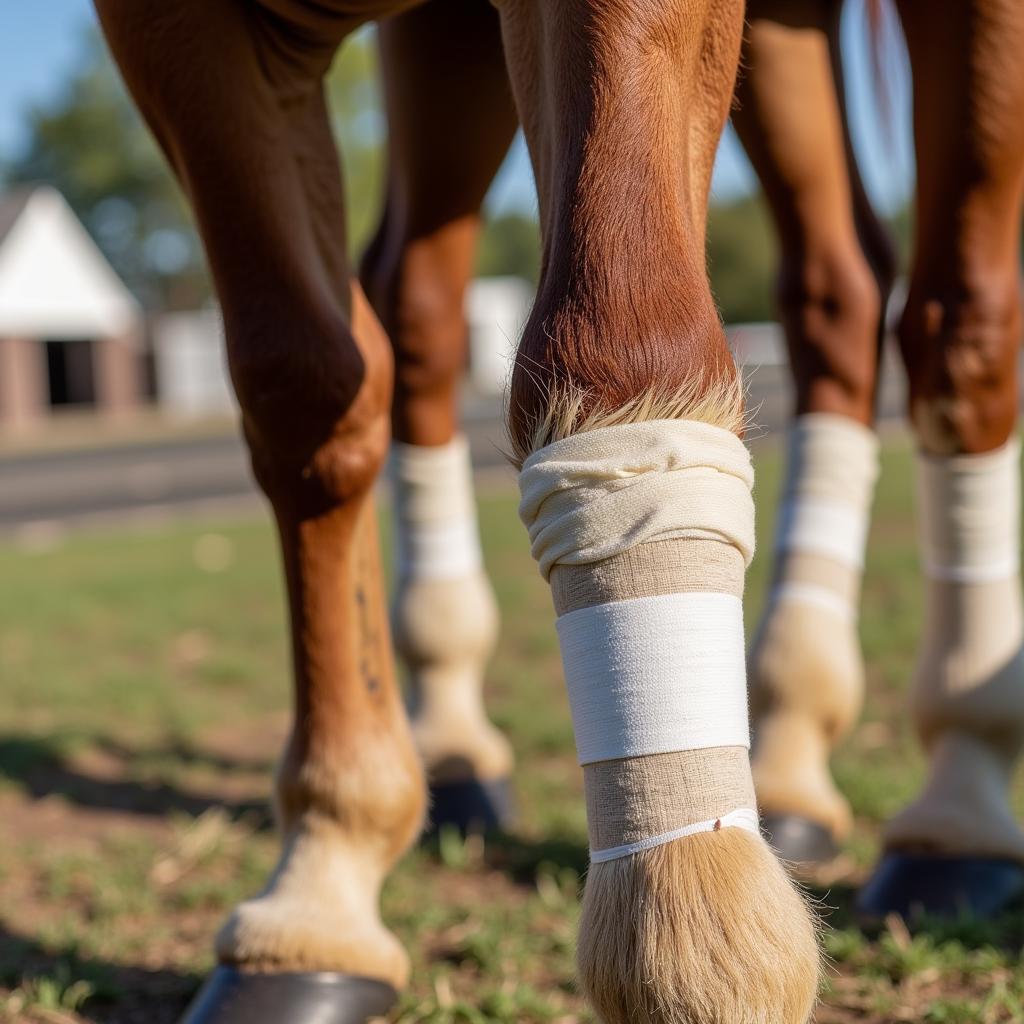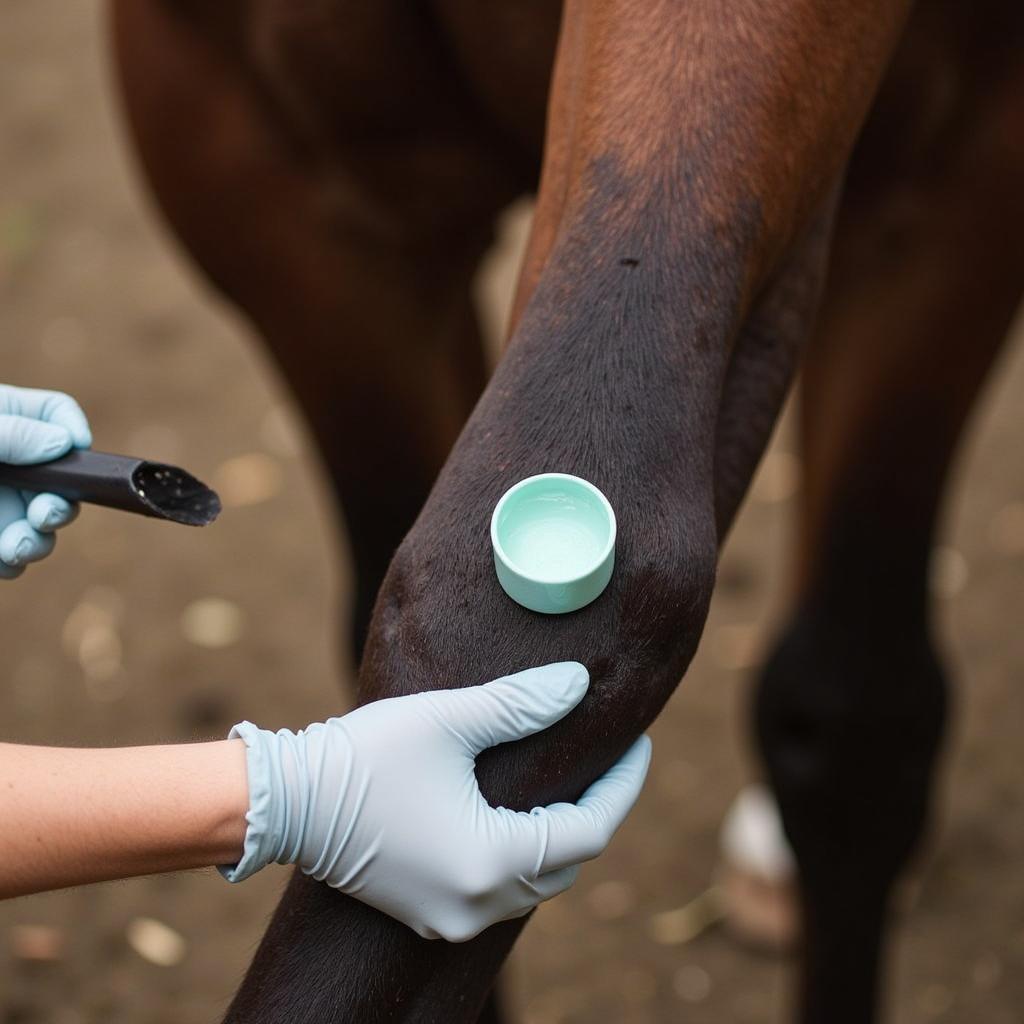Horse Drawing Salve has gained popularity in recent years, but what exactly is it, and how can it benefit your equine companion? This unique topical treatment, often utilizing natural ingredients, is designed to address a range of ailments in horses. From soothing sore muscles to promoting healing, horse drawing salve can be a valuable addition to your horse’s first aid kit.
What is Horse Drawing Salve?
Horse drawing salve is a topical ointment or balm applied directly to a horse’s skin to address various conditions. It’s called “drawing salve” due to the belief that certain ingredients can help “draw out” inflammation, infection, or impurities from the affected area. While the term “drawing” might seem a bit old-fashioned, the underlying principle is to encourage the body’s natural healing process.
 Horse leg with a bandage and drawing salve applied
Horse leg with a bandage and drawing salve applied
The Benefits of Horse Drawing Salve
Horse owners and caretakers turn to drawing salves for a variety of reasons, including:
- Muscle and Joint Support: Many drawing salves contain ingredients like arnica, known for their anti-inflammatory properties, which can help alleviate muscle soreness, stiffness, and joint pain.
- Wound Healing: Certain herbal ingredients found in drawing salves possess antiseptic and antimicrobial properties that can aid in wound cleansing and promote faster healing.
- Reducing Swelling: Drawing salves are believed to improve blood circulation, which can help reduce swelling and inflammation in the affected area.
- Hoof Care: Some drawing salves are specifically formulated to address hoof issues like abscesses, thrush, and cracks, promoting healthy hoof growth.
Common Ingredients in Horse Drawing Salve
The effectiveness of horse drawing salve often lies in its unique blend of natural ingredients. Some commonly found components include:
- Arnica: Known for its anti-inflammatory and pain-relieving properties, often used for muscle soreness and bruising.
- Calendula: A natural antiseptic and anti-inflammatory, often used to soothe skin irritations and promote wound healing.
- Comfrey: Believed to stimulate cell regeneration, often used for wounds, sprains, and fractures.
- Tea Tree Oil: A potent antiseptic and antifungal agent, often used for skin infections and hoof issues.
- Essential Oils: Various essential oils like lavender, eucalyptus, and peppermint are added for their soothing, anti-inflammatory, and antibacterial properties.
How to Choose the Right Horse Drawing Salve
Selecting the right horse drawing salve requires careful consideration of your horse’s needs and the specific condition you’re aiming to address.
- Read the Label: Carefully examine the ingredient list to ensure the salve is free of any substances your horse might be allergic to. Look for salves with natural, high-quality ingredients.
- Consult Your Veterinarian: Always consult with your veterinarian before using any new product on your horse, especially if they have pre-existing health conditions or are on medication.
- Consider the Application: Some salves are better suited for specific areas, such as hooves or wounds. Choose a salve that aligns with your horse’s needs.
Applying Horse Drawing Salve
When applying horse drawing salve, follow these general guidelines:
- Clean the Affected Area: Gently clean the area with mild soap and water, ensuring it’s dry before applying the salve.
- Apply a Thin Layer: Using clean hands or a glove, apply a thin layer of salve to the affected area, gently massaging it into the skin.
- Follow Package Instructions: Always adhere to the manufacturer’s instructions regarding application frequency and dosage.
- Monitor for Reactions: Keep a close eye on your horse for any adverse reactions, such as redness, swelling, or irritation. If any occur, discontinue use and contact your veterinarian.
 Applying drawing salve on a horse's leg
Applying drawing salve on a horse's leg
Conclusion
Horse drawing salve can be a beneficial addition to your horse’s first-aid kit, offering a natural approach to addressing various ailments. By understanding the ingredients, benefits, and proper application techniques, you can make informed decisions about incorporating horse drawing salve into your horse’s care routine. Remember to always consult with your veterinarian for personalized advice and to ensure the safety and well-being of your equine companion.
FAQs about Horse Drawing Salve
Can I use human drawing salve on my horse?
It’s not recommended to use human products on horses as they may contain ingredients toxic to equines.
How often can I apply horse drawing salve?
Application frequency varies depending on the product and the condition. Always follow the manufacturer’s instructions.
Can I use drawing salve on open wounds?
While some salves are suitable for wound healing, consult your veterinarian before applying any product to an open wound.
Where can I purchase horse drawing salve?
Horse drawing salve can be found at equine supply stores, online retailers, and some veterinary clinics.
Is horse drawing salve a substitute for veterinary care?
No, drawing salve should not replace professional veterinary care. Always consult your veterinarian for diagnosis and treatment of any health concerns.
Need further assistance? Our dedicated team at Justus Horses USA is available 24/7 to answer your questions and provide guidance. Contact us at Phone: 0772127271, Email: [email protected], or visit us at QGM2+WX2, Vị Trung, Vị Thuỷ, Hậu Giang, Vietnam. Your horse’s well-being is our top priority!